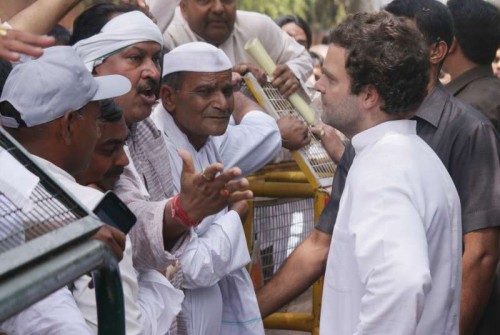
By Amulya Ganguli
From being caught snoozing in parliament to spending time in a mysterious hideout to the current photo-ops with tillers of the soil, Rahul Gandhi has been acquiring a whole range of political experience. The problem with his present frenetic pace, however, is that the question is bound to be asked as to how long he can keep it up, not the least because any slackening will provoke sceptics to reiterate the charge against him of being a part-timer.
But it isn’t only his penchant to swing from one extreme to another – absenteeism as a parliamentarian to speaking almost on a daily basis – which will be queried as his present combative political line. While his leftist tilt is evident, what may well be awaited is the extent to which he moves in this direction which is at odds with his party’s “neo-liberal” economics of the last quarter of a century.
Of equal interest will be to see whether Rahul will be given a free hand in this matter by his party or whether he will be reined in after some time.
For instance, will the Congress allow the heir apparent to continue his present tirades against businessmen since this will mean alienating a highly influential sector? In addition, there is the question of electoral funds for which most parties are dependent on the corporate czars.
Besides, it is not the Congress’s style to be so aggressively either Leftist or Rightist. Traditionally, the 130-year-old party has followed the middle path.
Indeed, its characteristic moderation has been its USP although the party always had both Leftists and Rightists in its ranks, such as Jawaharlal Nehru and Vallabhbhai Patel or Indira Gandhi and Morarji Desai (before he left the Congress).
For the present, Rahul’s main charge is that the Narendra Modi government is grabbing land from the peasants to repay the capitalists who had allegedly bankrolled his election campaign.
Such snide insinuations can win applause at public meetings, but the backroom boys of the Congress (and other parties) will be unhappy about the fallout, especially during private interactions with the business community.
There is another difficulty. In focussing on the agricultural sector, Rahul is venturing into a minefield where every point of argument has more than one counterpoint.
Not surprisingly, a Bharatiya Janata Party (BJP) spokesman slyly indicated that his party was waiting for the dauphin to slip up because of his simplistic approach to the subject and lack of intellectual ability.
A hint that a gaffe is possible is available from the limited nature of Rahul’s question-and-answer sessions with media personnel where the only points which he makes are that the farmers are in distress and that an uncaring government is in the hands of capitalists. After that, it is dhanyavad and goodbye.
If there is no examination of the possibility of relieving the distress via the developmental process of industrialization which eases the pressure on land, the possible reason is that Rahul is unable or unwilling to venture deep into the subject.
His visits to mandis or grain silos in Punjab, like his earlier slumming in Dalit huts in UP, are unlikely to make him aware of some of the key problems of agriculture in the state, which includes the cultivation of water-guzzling crops like paddy which has long been known to be unsuitable for the dry north Indian state. The resultant depletion of aquifers has been a cause of immense worry.
Yet, the emphasis in the speeches of both Sonia Gandhi and Rahul on raising the minimum support prices (MSP) for foodgrains underlines their lack of acquaintance with the nuances of the subject.
According to economist Ashutosh Varshney, such price incentives leave the government with less revenue to spend on irrigation and infrastructure. The resort to providing MSP may have been all right when the economy was in distress, but not now when it is in a much better shape.
Besides, in view of the encouragement given to farmers to grow paddy via the high MSP, Punjab is moving painfully slowly in opting for crop diversification in accordance with the advice of agricultural experts who want the cultivators to turn to the production of maize, mustard, cotton, oilseeds, pulses and other crops which require less water in a state where the water table is dropping by 33 cm every year.
Given the seriousness of the problem, two of Modi’s predecessors, Atal Bihari Vajpayee and Manmohan Singh, had called for switching from rice to Punjab’s traditional preference for makki ki roti and sarson ka saag, which are made of maize and mustard.
It will be unrealistic, however, to expect the Congress president and vice president to delve into such intricacies when their sole interest is to revive their party’s fortune by berating the government with whatever stick that comes handy.
In the process, they choose to turn a blind eye to the problem of fragmentation of holdings which reduces peasants to penury, and stall industrialization virtually all over the country, including tribal areas like Odisha’s Niyamgiri hills, preferring to let the inhabitants there to continue with their primitive hunter-gatherer existence.
The mother-and-son duo apparently see continuing backwardness as their passport to political success.